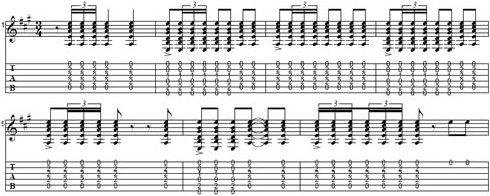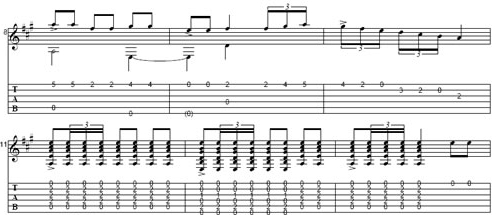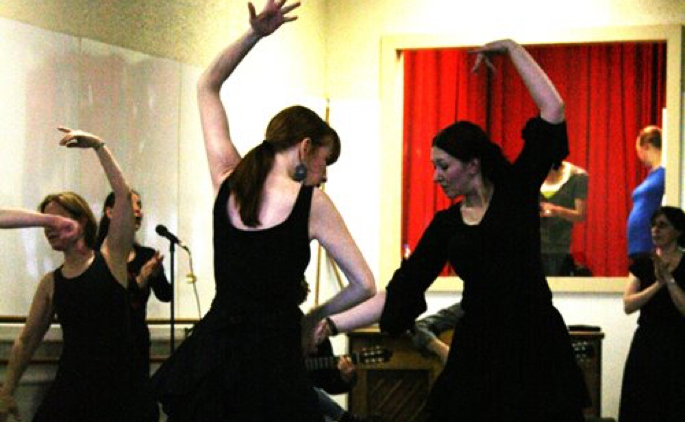Sevillana is a festive, energetic palo that is widely played, danced, and sung. It’s a central feature of Seville’s annula spring féria, and is a staple of beginning flamenco dance classes.
Sevillanas can be sung or played on a single or multiple guitars and all forms can be danced. Sevillanas are typically danced in sets of four.
The sevillana is a good place to start thinking about dance accompaniment not only because it is the form many dancers begin with, but also because it is a set palo with a pre-determined structure. Moreover, sevillana provides a good starting point for a discussion of the difference between which components of accompaniment can be varied and improvised and which ones need to stay put.
Structure and Compas
The basic sevillana has three pre-defined sections:
- a rhythmic introduction
- a salida (a melodic “departure”)
- a three part copla (containing verse or melody sections).
The sevillana can be counted in 3’s throughout with the accented beat on the 1 count:
1 2 3 1 2 3
Some flamencos will count the sevillana beginning on the 3 count. This is also “correct.” It’s best to keep in mind that counting is secondary to the actual music: whatever works is “correct”—as long as it keeps you in compas.
Sevillana in A Major
Here are the parts of a traditional sevillana in A major and a video example of the piece.
Download the PDF of the full arrangement.
Introduction
The introduction of the sevillana covers seven bars of three beats each. It is common for the first accented “one-beat” to be silent:

As with every part of the sevillana, you want to be sure to “feel” the accent of the first beat of each bar. These accented beats create the vital pulse which drives the sevillana. Playing in contratiempo (literally “counter rhythm”) can give your playing a more modern feel, but even if you don’t play every accented beat you need to know where those beats are—you might think of it as playing those beats “silently.”
Notice the chord change from E7 to A maj: it happens one beat before the accent. This gives sevillana its bouncy, rocking feel (that is, “rocking” like a pony, not “rocking” like Sammy Hagar).
Salida
The next part of the sevillana is the salida. In the introduction you have established the time, key, and aire (the feel) of the sevillana. The salida is where you establish its melodic theme. If you’re accompanying a singer, this is where the singer will begin his or her letra. In cante accompaniment, the salida may be very sparsely played or even silent, letting the singer instead provide the sevillana’s “departure”.
The salida spans six bars (eighteen beats):

Copla
The copla, which is the main body of the song, follows the salida. In the musical example here, you’ll notice that the copla is composed of both melodic lines and chords. Some sevillanas have coplas composed entirely of chords. Some coplas are all melody.
The first two sections, or tercios—of the traditional copla have twelve bars:

Notice that in this example the phrasing both of the salida and of the copla actually begin with pickup notes in the previous bars. Remember that the accented beat here is not on the actual beginning note of the copla melody, but on the “one” count of each bar.
The last tercio of the sevillana form ends on a “one” beat: think of it as picking up the “one” beat you “played silently” in the beginning. You’ll also notice that it is slightly shorter than the first two tercios: it is not followed by the brief rhythic sections found after tercios one and two.

As in this example, the final section of the copla may be a melodic variation of the first two sections. In cante accompaniment the chord progression may also change.
Interpretation
There are really no “rules” for melodic and rhythmic variations within the structure of sevillanas. As long as you stay in compas your playing will be “correct” and a dancer will be able to follow you. As such, the salida and copla are prime areas in the sevillana to begin working out your own interpretations. You’ll need to remember where beat one is (that is, stay in compas) and be aware of the tercio’s twelve bar structure, but otherwise be creative: try building on or altering the traditional melodies and progressions in order to work out your own musical ideas.
For instrumental accompaniment, each of the four individual sevillanas in a set is often in a different key. Key changes should relate to and build on each other. For example you may move from a sevillana in A major to one in A phrygian, then to E phrygian, ending with the final sevillana in E major.
You will also want to be attentive to the melodic relationships between individual sevillanas. While it’s not necessary to repeat themes or phrases from sevillana to sevillana, it usually sounds awkward to mix very traditional sounding sevillanas with ultra-modern or jazzy sounding sevillanas.
Next Steps
To learn more sevillanas to add to your repertoire, check out the other sevillana tabs here on Ravennea Flamenco.
To take the next step in complexity in dance accompaniment, check out the Alegria Accompaniment article, where we’ll explore structuring and playing the alegria form for dancers.

